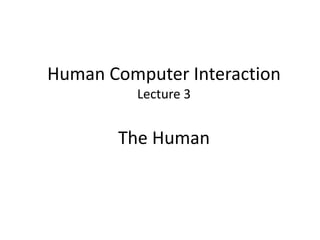
Hci lecture03
- 1. Human Computer Interaction Lecture 3 The Human
- 2. Long-Term Memory (LTM) • Repository for all our knowledge – slow access – slow decay, if any – huge or unlimited capacity (debatable) • Two types – episodic – serial memory of events – semantic – structured memory of facts, concepts, skills semantic LTM derived from episodic LTM
- 3. Long-term memory (cont.) • Semantic memory structure – provides access to information – represents relationships between bits of information – supports inference(drawing a conclusion) • Model: semantic network – inheritance – child nodes inherit properties of parent nodes – Semantic Network supports inference through inheritance
- 4. LTM - semantic network
- 5. Models of LTM - Frames • Information organized in data structures • Slots in structure instantiated with values for instance of data • Type–subtype relationships DOG Fixed legs: 4 Default diet: carnivorous sound: bark Variable size: colour COLLIE Fixed breed of: DOG type: sheepdog Default size: 65 cm Variable colour
- 6. Models of LTM - Scripts Model of stereotypical information required to interpret situation. Script has elements that can be instantiated with values for context Script for a visit to the vet Entry conditions: dog ill vet open owner has money Result: dog better owner poorer vet richer Props: examination table medicine instruments Roles: vet examines diagnoses treats owner brings dog in pays takes dog out Scenes: arriving at reception waiting in room examination paying Tracks: dog needs medicine dog needs operation
- 7. Models of LTM - Production rules Representation of procedural knowledge. Condition/action rules if condition is matched then use rule to determine action. IF dog is wagging tail THEN pat dog IF dog is growling THEN run away
- 8. LTM - Storage of information • rehearsal – information moves from STM to LTM • total time hypothesis – amount retained proportional to rehearsal time • structure, meaning and familiarity – information easier to remember
- 9. LTM - Forgetting Decay: – information is lost gradually but very slowly Interference: – New memory interferes with recall of a old memory (retroactive interference) – Old memory interferes with recall of newer memories (proactive interference) … affected by emotion
- 10. LTM - retrieval Recall: – information reproduced from memory can be assisted by cues, e.g. Categories Recognition: – information gives knowledge that it has been seen before – less complex than recall - information is cue
- 12. Deductive Reasoning • Deduction: – derive logically necessary conclusion from given premises. e.g. If it is Friday then she will go to work It is Friday Therefore she will go to work. • Logical conclusion not necessarily true: e.g. If it is raining then the ground is dry It is raining Therefore the ground is dry
- 13. Inductive Reasoning • Induction: – generalize from cases seen to cases unseen e.g. all elephants we have seen have trunks therefore all elephants have trunks. • Unreliable: – can only prove false not true … but useful!
- 14. Abductive reasoning • reasoning from event to cause e.g. Asim drives fast when he is angry. If I see Asim driving fast, assume he is angry. • Unreliable: – can lead to false explanations
- 15. Errors and mental models Types of error • slips – right intention, but failed to do it right – causes: poor physical skill, inattention etc. • mistakes – wrong intention – cause: incorrect understanding humans create mental models to explain behaviour. if wrong (different from actual system) errors can occur – Don’t ignore conventions, if done then give explicit support to build correct mental model
- 16. Individual differences • Long term – gender, physical and intellectual abilities • Short term – effect of stress or fatigue • Changing – age These differences should be taken into account into our designs. At extremes a decision may exclude a section of the user population. E.g. Visually impaired
- 17. Psychology and the Design of Interactive System • Some direct applications – e.g. blue acuity is poor blue should not be used for important detail • However, correct application generally requires understanding of context in psychology, and an understanding of particular experimental conditions • A lot of knowledge has been distilled in – guidelines (chap 7) – cognitive models (chap 12) – experimental and analytic evaluation techniques (chap 9)